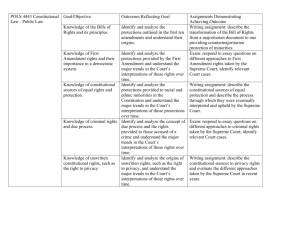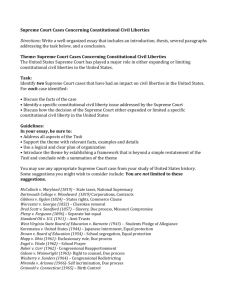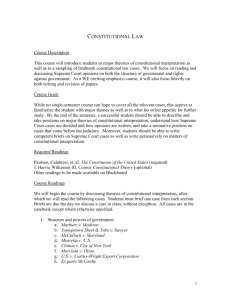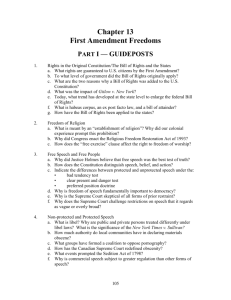Chapter 16 First Amendment Freedoms
advertisement
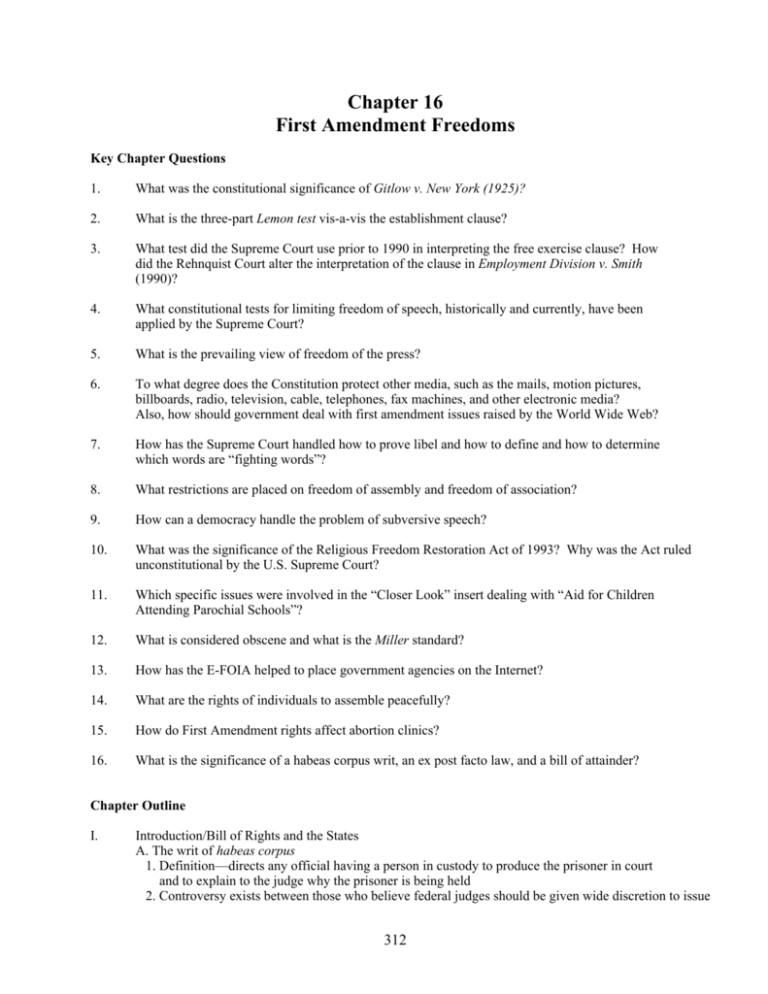
Chapter 16 First Amendment Freedoms Key Chapter Questions 1. What was the constitutional significance of Gitlow v. New York (1925)? 2. What is the three-part Lemon test vis-a-vis the establishment clause? 3. What test did the Supreme Court use prior to 1990 in interpreting the free exercise clause? How did the Rehnquist Court alter the interpretation of the clause in Employment Division v. Smith (1990)? 4. What constitutional tests for limiting freedom of speech, historically and currently, have been applied by the Supreme Court? 5. What is the prevailing view of freedom of the press? 6. To what degree does the Constitution protect other media, such as the mails, motion pictures, billboards, radio, television, cable, telephones, fax machines, and other electronic media? Also, how should government deal with first amendment issues raised by the World Wide Web? 7. How has the Supreme Court handled how to prove libel and how to define and how to determine which words are Òfighting wordsÓ? 8. What restrictions are placed on freedom of assembly and freedom of association? 9. How can a democracy handle the problem of subversive speech? 10. What was the significance of the Religious Freedom Restoration Act of 1993? Why was the Act ruled unconstitutional by the U.S. Supreme Court? 11. Which specific issues were involved in the ÒCloser LookÓ insert dealing with ÒAid for Children Attending Parochial SchoolsÓ? 12. What is considered obscene and what is the Miller standard? 13. How has the E-FOIA helped to place government agencies on the Internet? 14. What are the rights of individuals to assemble peacefully? 15. How do First Amendment rights affect abortion clinics? 16. What is the significance of a habeas corpus writ, an ex post facto law, and a bill of attainder? Chapter Outline I. Introduction/Bill of Rights and the States A. The writ of habeas corpus 1. DefinitionÑdirects any official having a person in custody to produce the prisoner in court and to explain to the judge why the prisoner is being held 2. Controversy exists between those who believe federal judges should be given wide discretion to issue 312 writs of habeas corpus to protect constitutional rights and those who believe the writ has been abused state prisoners 3. The Supreme Court has severely restricted the use of these writs by federal judges 4. The 1996 Antiterrorism and Effective Death Penalty Act restricts habeas corpus B. Ex post facto laws and bills of attainder 1. The Constitution forbids both the national and state governments from passing ex post facto laws and enacting bills of attainder 2. Bill of attainder is a legislative act inflicting punishment without judicial trial on named individuals or members of a specified group C Selective incorporation (note 1925 Gitlow v. New York decision) 1. The Supreme Court selectively incorporated the Bill of Rights into the due process clause 2. Today, only exceptions are Amendments 2, 3, 7, 10, and grand jury requirements of the Fifth Amendment 3. Distinction between provisions of the Bill of Rights that are incorporated into the Fourteenth Amendment from those that are not 4. The Supreme Court has found constitutional protection for other fundamental rights D New judicial federalism (U.S. Constitution should set minimum, not maximum standards) 1. Renewal of interest in state constitutions as independent sources of additional protection for civil liberties and civil rights 2. Argue for state courts to provide more protection from their bill of rights II. Freedom of Religion A. The establishment clause 1. Prevailing doctrine stems from Everson v. Board of Education (1947), that created a strict separation of church and state 2. Lemon v. Kurtzman (1971): Lemon test is a three-part test supported by justices John Paul Stevens, Ruth Bader Ginsburg, and Stephen Breyer 3. Endorsement test supported by Justice Sandra Day OÕConnor 4. Nonpreferential test supported by Chief Justice William Rehnquist and Justices Antonin Scalia and Clarence Thomas 5. Strict separation supported by Souter, Stevens, Ginsburg, Breyer 6 What the establishment clause forbids (schools cannot encourage or sponsor) B. Parochial school aid (ÒA Closer LookÓ insert) 1. Permissible and impermissible public aid to religion using the Lemon test 2. Aid must have secular purpose 3. Tax funds cannot be used in religious schools to pay teachers C. The Free exercise clause 1. Right to hold any or no religious belief is one of our few absolute rights a. Tension exists between the two religion clauses b. The Supreme Court applied the compelling interest test prior to 1990 c. In 1990, the Rehnquist Court discarded the compelling interest test except as it applied to laws denying people unemployment compensation; in Employment Division v. Smith (1990), the Court ruled that a government no longer has to show a compelling interest in order to apply its general laws to religious practices D. The Religious Freedom Restoration Act of 1993 1. Designed to restore the use of the compelling interest test 2. Exempts people from laws and governmental actions that burden their religious freedom 3. It is unclear whether Congress has the authority to diminish the power of state governments and restrict their power to legislate 4. RFRA ruled unconstitutional 5. Case of University of Virginia and Christian ÒWide AwakeÓ student newspaper 313 III. Free speech and free people A. Distinction among belief, speech, and action B. The Act of Judging: Line-DrawingÑFree speech questions require judges to weigh many Factors such as motives of government, what was said, where was it said, how was it said? B. Historic constitutional tests 1. The bad tendency test (rooted in English common law) a. Judges presumed it was reasonable to ban corrupting or illegal speech b. Has been abandonedÑtoo broad, runs counter to First Amendment; c. Some legislators still hold position; college students may also be supportive 2. The clear and present danger test (Schenck v. United States, 1919) a. No government should be allowed to restrict any particular speech unless it can demonstrate that there is such a close connection between the speech and an illegal action that the speech itself takes on the character of the action b. Yelling ÒfireÓ in a crowded theater when there is no fire 3. The preferred position doctrine a. Freedom of expression has a preferred position in our constitutional hierarchy; judges have a special duty to protect these freedoms and should be most skeptical about laws trespassing on them IV. Nonprotected and protected speech A. Libel (written defamation of character; see Sedition Act of 1789; Smith Act of 1940) 1. Sedition is defined as attempting to overthrow the government by force or to interrupt its activities by violence 2. 1798 sedition law, while allowing the jury to decide truth of statements, led to popular reaction against Federalists and their subsequent political defeat 3. Smith Act forbids persons to advocate overthrow of the government with the intent to bring it about, to distribute matter teaching or advising the overthrow of government by violence, and to organize knowingly any group having such purposes 4. In Dennis v. United States (1950), the Court ruled that the Smith Act could apply to Communist Party leaders 5. Seditious speech, if narrowly defined to cover only the advocacy of immediate and concrete acts of violence, is not constitutionally protected 6. In New York Times v. Sullivan, the Supreme Court established the guidelines for libel cases a. Public officials and public figures must first prove "actual malice" b. State laws may allow private persons to collect damages without proving actual malice B. Obscenity and Pornography 1. Miller v. California (1973) gave constitutional definition of obscenity 2. Obscenity not entitled to constitutional protection 3. X-rated movies are entitled to some constitutional protection, but less protection than political speech, and they are subject to greater governmental regulation 4. Sexually explicit materials about or aimed at minors are not protected by the First Amendment C. Pornography 1. Advocates of regulation of pornography argue that just as sexually explicit materials about minors are not entitled to First Amendment protection, so should there be no such protection for pornographic materials 2. Pressure for regulation comes mainly from political/religious conservatives; some feminists have joined in, arguing that pornography is degrading/perpetuates sexual discrimination/violence D. Fighting words 1. Governments may punish certain well-defined and narrowly limited classes of speech that by their very utterance inflict injury or tend to incite an immediate breach of peace E. Commercial speech (ads, commercials)ÑCourt recently given greater protection to this speech such as in 44 Liquormart Inc. v. Rhode Island (1996) where Court struck down a law banning the advertising of the price of alcoholic drinks 314 F. Protected speech 1. Prior restraint a. Judges are most suspicious of restraints prior to publication 2. Void for Vagueness a. Law must not allow those who administer them so much discretion that they could discriminate against those whose views they dislike b. Law must not be so vague that people are afraid to exercise protected freedoms 3. Least drastic means a. Legislature may not pass a law which violates First Amendment if other ways to solve the problem exist 4. Content and viewpoint neutralityÑlaws that apply to all kinds of speech and all views less likely to be struck down (see St. Paul, Minnesota example in text) V. Freedom of the press A. Does the press have the right to withhold information? (some states have passed shield laws) B. Does the press have the right to know? 1. Courts have protected press's right to publish, but have not acknowledged a "right to know" a. Sunshine laws require "open meetings" of public agencies C. The 1966 Freedom of Information Act 1. Liberalized access to non-classified government records 2. More than 250,000 people have requested information (90% granted) 3. Clinton in 1995Ñdeclassified government documents after 25 years 4. Electronic Freedom of Information Act of 1996 requires most federal agencies to put their files online and to establish an index of their recordsÑNASA a leader (UFO documents!) D. Free press versus fair trials 1. Supreme Court has ordered new trials, or instructed judges to impose sanctions on policed prosecutors due to inflammatory publicity 2. Judges in some states have prohibited TV coverage VI. Other media and communications A. The mails 1. Government censorship of mail is unconstitutional 2. Household censorship of mail is constitutional B. Motion pictures and plays 1. Laws calling for submission of films to a government review board are constitutional only if there is a prompt judicial hearing; the burden is on the government to prove that the film is obscene 2. Live performances are entitled to constitutional protection C. Handbills, sound trucks, and billboards 1. Forms are entitled to constitutional protection D. Broadcast and Cable Communications 1. Mass media broadcasting receives least First Amendment protection also regulated by FCC 2. FCC can impose sanctions for "filthy language" or prevent license renewal for broadcasting not in the public interest (Infinity Broadcasting and Howard Stern) 3. Telecommunications Act of 1996 allows phone companies, broadcasters, and cable TV to compete with one another; Bill calls for new regulations, outlawing the transmission of "indecent materialÓby requiring "V-chips" on new television sets 4. The Supreme Court has decided that cable television is entitled to less constitutional protection than newspapers but more than broadcast television; the Court, however, is not in agreement on precisely how that protection applies 5. Cable TV stations must carry signals of local broadcast TV stationsÑsee 2000 Court ruling in U.S v. Playboy Entertainment Group. F. Telecommunications and the Internet 1. Congress struggling with issues raided by cyberspace communications 315 2. Court distinguished between limited ban on radio/TV messages vs. phones, cable, Internet 3. See Reno v. ACLU regarding Communications Decency Act of 1996ÑCourt struck down provisions of the Communications Decency Act of 1996 that had made it a crime to send obscene messages to anyone under 18 years of age (Internet unique, less intrusive) VII. Freedom of Assembly A. Freedom of assembly (ÒMillion Youth MarchÓ example) 1. Police must have right to order groups to disperse (public order) 2. Issue of the ÒhecklerÕs vetoÓ? B. Public forums and time, place, and manner regulations 1. Governments may not specify what can or cannot be said, but they can make reasonable time, place, and manner regulations for the holdings of assemblies, protests, or gatherings 2. The extent to which governments may limit access depends on the kind of forums involved: a. Public forums (historically associated with free exercise such as streets, parks) b. Limited public forums (public property such as city hall of schools after-hours) c. Nonpublic forums (libraries, courthouses, government offices)Ñcan not interfere with normal activities in order to stage a public protest 3. Civil disobedience is not a protected right 4. Federal crime to obstruct abortion clinic activity 316
